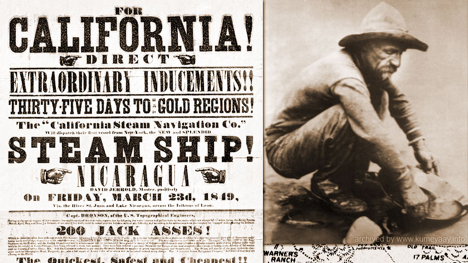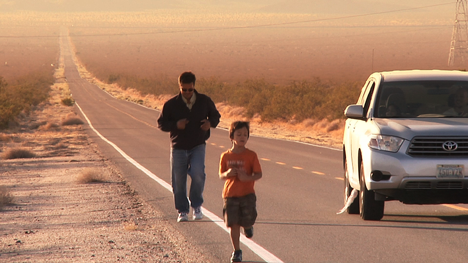Why Protect Native Lands?
Gary G. Ballard, writes, “The great California Gold Rush 1848-1855 is historically paramount to Native American Indian history in California — it was estimated that some 300,000 immigrants poured into California during this seven-year period. When James Marshall discovered gold at Sutter’s Mill in Coloma, California, on January 24th, 1848, it was estimated there were some 150,000 Indigenous Native American Indians living in California.
By 1870 (22 years later) it was estimated there were only 30,000 Indians left living in California mostly as a result of the California Gold Rush— 120,000 California aboriginal Indians were lost in this 22-year period.
By 1900 it was estimated that less than 16,000 California Indians had survived the invasion of their homelands (some 134,000 California Indians were lost during this 52-year period while the United States Government was in control of California). It is believed the Kumeyaay (Tipay-Iipay-Diegueño) Indians — one of the largest and strongest pre-contact tribal groups in California — had only 1,000 surviving tribal members at the turn of the 20th century (1900).
 In 2010, Robert Lundahl was asked to write a legal complaint on behalf of CARE (Californians For Renewable Energy) and La Cuna de Aztlán Sacred Sites Protection Circle, about the destruction of sacred sites by the development of Solar and Wind energy across the Mojave and Colorado deserts.
In 2010, Robert Lundahl was asked to write a legal complaint on behalf of CARE (Californians For Renewable Energy) and La Cuna de Aztlán Sacred Sites Protection Circle, about the destruction of sacred sites by the development of Solar and Wind energy across the Mojave and Colorado deserts.
It inspired an interest in making a film on the topic–called “Who Are My People?”, just completed. The film is based loosely on the closing argument section of the lawsuit.
The film is titled “Who Are My People: The Destruction of Indigenous Land and People by Industrial Solar and Wind Across the Deserts of the Southwest.” The title is a double entendre. First: it is a statement about the effects of these solar projects which will wipe out the cultural continuum of Native Americans- leaving future generations of Native Americans to ask “Who are my People?” since they won’t have access to their artifacts, burials, and traditions.
Additionally, in the process of making the documentary and writing the lawsuit, Mr. Lundahl was forced to ask himself “Who are my People (the white, politically-liberal California-born Americans) to do such a thing in my name and with my tax dollars?!” The resulting film is both powerful and revealing. The truth, shown through Mr. Lundahl’s documentary film lens, may be uncomfortable, but it is undeniable.
Mr. Lundahl garnered the requisite background experience with the topics through projects in Washington State with tribal communities and energy projects, beginning in 1993. Along the way, he was exposed to the basics of treaty law and other federal laws affecting Native communities and tribes.
Mr. Lundahl feels a strong personal connection with the West, especially the desert and tribal lands of the Southwest. He continues to be concerned that cultural resources, and Native sovereignty are in jeopardy. The lawsuit and the film “Who are My People” is his attempt to make the cultural genocide, going on in the name of “green energy federal policy,” visible and undeniable.
The following is an excerpt, re-formatting and alternate presentation of the closing argument section of the lawsuit. The full legal complaint document is also available with footnotes: http://issuu.com/advocacyfilms/docs/the_final_bullet
-Lura Lee, 4/14, Tampa, Fla.
The Final Bullet:
Harm and The Removal of the American Indians From Traditional Lands, Land Based Cultural Practices, and the Environment.”
The harm that large Solar Development potentially will inflict upon the American Indians and American Indian communities of Southern California might best be described as the “Final Bullet.”
Overrunning of Native People: A New Gold Rush?
Plaintiff Alfredo Acosta Figueroa, who traces his family lineage to Sonoran (Yaqui) miners working in the Sierra Nevada foothills during the1840s discusses why his family was forced to move south to the area near Blythe, “They overran us,” he says tersely.
Gary G. Ballard, writes, “The great California Gold Rush 1848-1855 is historically paramount to Native American Indian history in California — it was estimated that some 300,000 immigrants poured into California during this seven-year period. When James Marshall discovered gold at Sutter’s Mill in Coloma, California, on January 24th, 1848, it was estimated there were some 150,000 Indigenous Native American Indians living in California.
By 1870 (22 years later) it was estimated there were only 30,000 Indians left living in California mostly as a result of the California Gold Rush— 120,000 California aboriginal Indians were lost in this 22-year period.
By 1900 it was estimated that less than 16,000 California Indians had survived the invasion of their homelands (some 134,000 California Indians were lost during this 52-year period while the United States Government was in control of California). It is believed the Kumeyaay (Tipay-Iipay-Diegueño) Indians — one of the largest and strongest pre-contact tribal groups in California — had only 1,000 surviving tribal members at the turn of the 20th century (1900).
Sacramento Bee Staff Writer Stephen Magagnini, in a Jan. 18, 1998 article entitled, “Indians’ Misfortune Was Stamped in Gold,” details the effects on native life and indigenous population. “It has been the melancholy fate of California Indians to be more vilified and less understood than any other of the American aborigines,” said Stephen Powers in his 1877 book “Tribes of California.” “They were once probably the most contented and happy race on the continent … and they have been more miserably corrupted and destroyed than any other tribes within the Union. They were certainly the most populous, and dwelt beneath the most genial heavens, amidst the most abundant natural productions, and they were swept away with the most swift and cruel extermination.”
The “Gold Rush” of 1848 resulted in not only cultural and social impacts of lasting harm to American Indians and Indian groups such as the Kumeyaay, it resulted in severe destruction of California’s ecosystems and natural environments. Native Americans, dependent on traditional hunting and gathering, became the victims of starvation and disease, as gravel, silt and toxic chemicals from prospecting operations killed fish and destroyed habitats. The surge in the mining population also resulted in the disappearance of game and food gathering locales as gold camps and other settlements were built amidst them. Later farming spread to supply the camps, taking more land from the use of Native Americans. Starvation often provoked the Native tribes to steal or take by force food and livestock from the miners, increasing miner hostility and provoking retaliation against them.
The Act for the Government and Protection of Indians, passed on April 22, 1850 by the California Legislature, allowed settlers to continue the California practice of capturing and using Native people as bonded workers. It also provided the basis for the enslavement and trafficking in Native American labor, particularly that of young women and children, which was carried on as a legal business enterprise. Native American villages were regularly raided to supply the demand, and young women and children were carried off to be sold, the men and remaining people often being killed in genocidal attacks.
 Father Junípero Serra
Father Junípero Serra
The Mission System
The Gold Rush of 1848 was not the first series of horrors to befall the American Indians of Southern California. The “Mission System” had already broken “The Continuum” of cultural practice and lifeways of many tribal communities a generation or two before. The Spanish missions in California comprise (d) [sic] a series of religious and military outposts established by Spanish Catholics of the Franciscan Order between 1769 and 1823, to spread the Christian faith among the local Native Americans. The missions represented the first major effort by Europeans to colonize the Pacific Coast region, and gave Spain a valuable toehold in the frontier land. The settlers introduced European livestock, fruits, vegetables, cattle, horses and ranching into the California region; however, the Spanish occupation of California also brought with it serious negative consequences to the Native American populations with whom the missionaries came in contact.
Despite romantic portraits of California missions they were essentially coercive religious, labor camps organized primarily to benefit the colonizers. The overall plan was to first militarily intimidate the local Indians with armed Spanish soldiers who always accompanied the Franciscans in their missionary efforts. At the same time the newcomers introduced domestic stock animals that gobbled up native foods and undermined the free or “genitle” tribes efforts to remain economically independent.
Local tribes were relocated and conscripted into forced labor on the mission, stretching from San Diego to San Francisco. Disease, starvation, over work, and torture decimated these tribes. Many were forcibly converted and baptized as Roman Catholics by the Franciscan missionaries at the missions. Mission Indians were from many Californian Native American tribes that were relocated together in new mixed groups and renamed after the responsible mission. For instance the Payomkowishum were renamed “Luiseños” after the Mission San Luis Rey and the Acjachemem were renamed the “Juaneños” after the Mission San Juan Capistrano. The overall cultural genocide of the mission era resulted in the original linguistic, spiritual, and cultural practices forbidden and lost.
In 1780, Father Junípero Serra wrote: “that spiritual fathers should punish their sons, the Indians, with blows appears to be as old as the conquest of the Americas; so general in fact that the saints do not seem to be any exception to the rule.” Raymond Starr of The Journal of San Diego History , writes, “Ironically, it is the interviews with the scholars defending Serra that contain the strongest evidence against the mission system. From the interviews in the Serra Report, one gets the impression that Serra’s work can be defended only by demeaning the culture and traditions of the native Californians.”
v“The work of A. L. Kroeber, Sherburne Cook, Robert Heizer (all cited in the text) and others establishes that the arrival of the Europeans was a cultural and demographic catastrophe for the California Indians. Too often it is forgotten that Serra aimed not just to convert the Indians to Catholicism but to eradicate Indian culture as well. It is in this sense that the book’s subtitle. “A Legacy of Genocide” is justified. Many of Serra’s fiercest critics are individuals actively engaged in efforts to heal Indian society by recovering and honoring the traditional ways that bound tribes together for centuries. The attempt to sanctify a man who dedicated his life to the destruction of those ways is, understandably, galling to them.”
 The Definition of Harm
The Definition of Harm
How are we to define the harm incurred by the cumulative effects of Federal, state, and territorial policies acting to the detriment of the American Indian and American Indian Sovereignty? Could it be considered spiritual? Certainly, given the spiritual basis of the cultures themselves, grounded in the relationships with the land and the cultural expressions of history and tribal tradition on the land, it is.
As Anthropologist Lowell Bean explains in an interview with Film Maker, Robert Lundahl: “Well, as you know, history –history becomes religion…. You look at our own cultures; ancient and important architecture that is part of our political — our religious history becomes sacred. We deem it a treasure and we put a name on it and we put rules out that no one can endanger that. It’s not unlike — every culture does it. So if you — if there’s a village site out in the desert and someone’s going to put a road over it, people are concerned. That’s part of their traditional history and traditional history really is sacred to everybody.” But what we might call “spiritual” harm is simultaneously historical harm; it is also economic and physical harm.
Displacement, De-Culturalization, Destruction
The effects of de-culturalization have had negative effects across the entire spectrum of human life and well being. The solar projects (as currently proposed) continue the non-native tradition of displacement and de-culturalization and combines those effects with the added effect of significant environmental destruction. Construction of the 5 Challenged Projects will set a precedent of the purveyance of inadequate EIS’s and inadequate Section 106 consultation, procedures which aside from being unlawful actions in their own right, will facilitate the development of 245 additional “renewable’ energy projects, to be strewn across the western deserts, with limited concern for their impacts. In so witnessing we would then silently participate in the collapse of ecosystems, the extinctions of undocumented species of flora and fauna, and the collapse of whole cultures and peoples, histories and identities.
In an interview with Film Maker Robert Lundahl, Dr. Jim Andre explains: “I’m a botanist, and I study the plants in the California deserts and Nevada deserts. What has really struck me by this area is the level at which we are just scratching the surface in terms of documenting the flora. You can assume roughly about 5 to 10 percent of the species out there remain undescribed to date. We continue to describe species over the last hundred years at about 25 species per decade. There are very few areas in North America where you can go and find that kind of a frontier, floristic frontier of sorts.” Unfortunately, should the number of large Solar Developments currently in the application stages be permitted, their cumulative impacts would wipe out the desert ecosystems and much of the flora and fauna with their intrinsic values.
Jim Andre, Ph.D continues to explain: “One of the things I did is I looked at – once it reached about 250 proposed projects — all ranging from 5 to 25,000 acres each, totaling 2 million acres just for California — I decided to do a quick and dirty analysis of how many acres of public lands have been mined since the passage of the 1872 Mining Act. We will exceed that total number of acres in three to five years if all these proposed projects were to go through. So in a flash we would basically have the largest most disruptive impact that have been recorded in a short period of time. That is — that is remarkable. That is a remarkable thing. When you consider the importance of these systems to provide corridors for species to move as climate changes, whether it’s human caused change or just the natural course of variation in climate change, you’ve really done in the entire ecosystem at that scale.”
Breaking the Native American Continuum on Sacred Lands
Sacred sites and cultural resources are components of an expansive library of indigenous knowledge about how to live both on the land and with the land. When “The Continuum” is disrupted and the links between the social and the natural broken, solutions for future problems become unavailable. And as the dominant society looks to renewable energy implementations in order to provide relief and to mitigate its addiction to the use of fossil fuels with their destructive byproduct, atmospheric carbon, perhaps we can come to understand “renewability” through a traditional relationship with the land. Currently we are stimulating yet another a “boom cycle” followed by a bust, a fast tracked “Gold Rush” that destroys cultures and the environment in the name of “Overriding Concerns.” We are in the process of revisiting the evils of our past.
 Toward a New Trail of Tears
Toward a New Trail of Tears
The forced removal of American indigenous peoples from their ancestral lands is one of the darkest chapters in American history. Perhaps few today realize, however, that this forced removal did not result from isolated acts of Western settlers; rather, it was set in motion by the federal government. In 1827, the Cherokee nation, located within the boundaries of the state of Georgia, adopted a written constitution modeled after the U.S. Constitution, which declared them to be a sovereign, autonomous nation. At the time, the Cherokee nation possessed “a thriving agricultural economy, a written language, and a formal government, including a legislature, and courts. The following year, the state of Georgia passed a law assimilating Cherokee lands into Georgia’s northwestern counties. In 1829, the state passed a law rendering the Cherokee territory located within Georgia boundaries subject to the laws of Georgia, effectively abolishing existing Cherokee laws and customs. The Cherokee nation filed suit in federal court to enjoin the enforcement of the Georgia laws, but the matter was dismissed for lack of jurisdiction. A year after dismissing the case, however, the Supreme Court, in an opinion authored by Chief Justice John Marshall, determined the Cherokee nation to be “a distinct community, occupying its own territory, . . . in which the laws of Georgia can have no force, and which the citizens of Georgia have no right to enter, but with the assent of the Cherokees themselves”
Prior to the Court’s decision, however, Congress had passed the Indian Removal Act, authorizing the President to compel Indian Tribes living east of the Mississippi River to migrate westward. Additionally, in 1830, the governor of Georgia had announced that gold had been discovered on the Cherokee lands, prompting widespread trespasses onto Cherokee territory by Georgia citizens searching for gold. Therefore, the governor of Georgia, together with numerous state officials, announced that they would not obey the mandate of the Supreme Court. Moreover, upon learning of the Worcester decision, President Andrew Jackson is fabled to have retorted: “Well, John Marshall has made his decision—now let him enforce it.” When they realized that the executive branch had no intention of honoring the decision of the Court, the Cherokee nation reluctantly entered into the Treaty of New Echota in 1835. Soon afterward, “[n]early sixteen thousand Cherokees walked `silent and resigned’ from Georgia to their new homes in what became eastern Oklahoma. This journey has been called the `Trail of Tears’ because the Indians were leaving their ancestral lands under the most harsh conditions imaginable.”
“The Cherokee are probably the most tragic instance of what could have succeeded in American Indian policy and didn’t. All these things that Americans would proudly see as the hallmarks of civilization are going to the West by Indian people. They do everything they were asked except one thing. What the Cherokees ultimately are, they may be Christian, they may be literate, they may have government like ours, but ultimately they are Indian. And in the end, being Indian is what kills them.” stated Richard White, an historian who specializes in the topic.
The Pattern of Harm
The pattern of legislative and regulatory actions by the Federal Government, which have caused harm to American Indians dates from the nation’s inception. It is a sad legacy given the potential for cultural interactions, shared histories, and future perspectives that are possible.
The permitting, siting, and implementation of large solar projects on tribal lands continue this pattern of disregard and abuse. In ruling for declaratory and injunctive relief, the court has an opportunity to establish a more consistently respectful and sovereign path.
